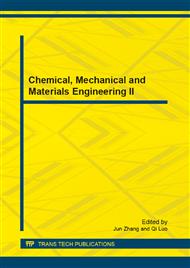[1]
FANZhenxiang.,&CHENGHaifeng.(2005).Development of Thermal Protection Materials. Materials Review, 19,13-16.
Google Scholar
[2]
T.R. Crompton. (2010).Thermo-oxidative Degradation of Polymers. Lightning Source Inc.
Google Scholar
[3]
L.G. Hanu.,&G.P. Simon.(2006).Thermal stability and flammability of silicone polymer composites.Polymer Degradation&Stability,91,1373-1379.
DOI: 10.1016/j.polymdegradstab.2005.07.021
Google Scholar
[4]
L.G. Hanu.,&G.P. Simon.(2005).Preferential orientation of muscovite in ceramifying silicone composites. Materials science&engineering a,398,180-187.
DOI: 10.1016/j.msea.2005.03.022
Google Scholar
[5]
J.Mansouri.,&R.P. Burford.(2006).Pyrolysis behaviour of silicone-based ceramifying composites. Materials science&engineering a,425,7-14.
DOI: 10.1016/j.msea.2006.03.047
Google Scholar
[6]
Rimantas LEVINSKAS.,&Romualdas KEZELIS.(2011).High temperature ablation of composite material under plasma jet impact.M aterials science, Vol.17,No.4,ISSN 1392-1320.
DOI: 10.5755/j01.ms.17.4.781
Google Scholar
[7]
C.M. Bhuvaneswari.,&S.D. Kakade.(2008).Filled ethylene-propylene diene terpolymer elastomer as thermal insulator for case-bonded solid rocker motors.Defence science journal, Vol.58,No.1,94-102.
DOI: 10.14429/dsj.58.1628
Google Scholar
[8]
Jung-Hye Eom.,&Young-Wook Kim.(2010). Effect of additives on mechanical properties of macroporous silicon carbide ceramics.Met&Mater,Vol.16,No.3,399-405.
DOI: 10.1007/s12540-010-0609-3
Google Scholar
[9]
Gilberto Petraconi.,&Choyu Otani.(2010).Degradation of carbon-based materials under ablative conditions produced by a high enthalpy plasma jet.Journal of aerospace technology&Management, 33-40.
DOI: 10.5028/jatm.2010.02013340
Google Scholar
[10]
Qian-gang FU.,&Hui XUE.(2010). Anti-oxidation property of a multi-layer coating for carbon/carbon compositesin a wind tunnel at 1500℃.New Carbon Materials,25,279-284.
DOI: 10.1016/s1872-5805(09)60033-0
Google Scholar
[11]
Jigang Wang.,&Nan Jiang.(2006).Study on the structural evolution of modified phenol-formaldehyde resin adhesive for the high-temperature bonding of graphite.Journal of nuclear materials,348,108-113.
DOI: 10.1016/j.jnucmat.2005.09.008
Google Scholar
[12]
Kimberly A.Trick.,&Tony E.Saliba.(1995).Mechanisms of the pyrolysis of phenolic resin in a carbon/phenolic composite.Carbon,Vol.33,No.11,1509-1515.
DOI: 10.1016/0008-6223(95)00092-r
Google Scholar
[13]
R.Pailler.,&R.Naslain. (2002).Enhancement of the oxidation resistance of interfacial area in C/C composites.Journal of the European Ceramic Society22,1011-1021.
DOI: 10.1016/s0955-2219(01)00411-3
Google Scholar
[14]
Mohamed O. Abdalla.,&Adriane Ludwick.(2003).Boron-modified phenolic resins for high performance applications.Polymer,44,7353-7359.
DOI: 10.1016/j.polymer.2003.09.019
Google Scholar
[15]
S.Labruquere.,&H.Blanchard.(2002).Enhancement of the oxidation resistance of interfacial area in C/C composites.Journal of the European Ceramic Society22,1001-1009.
Google Scholar


